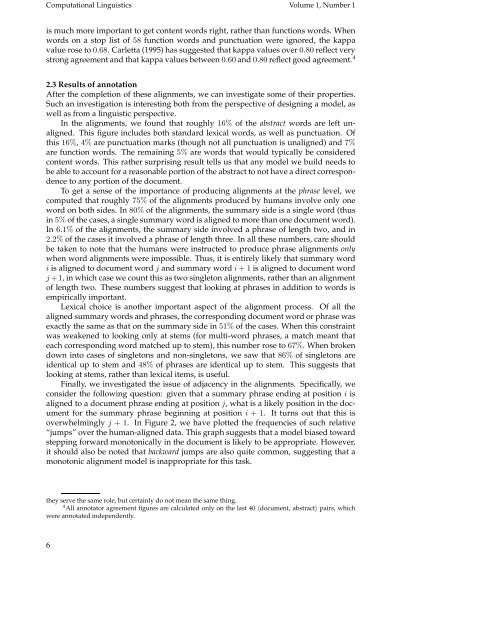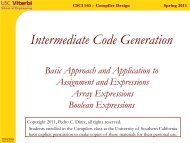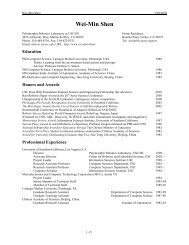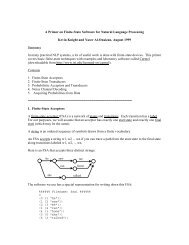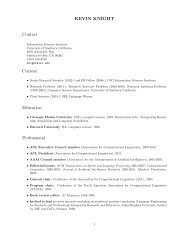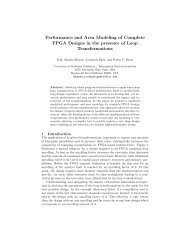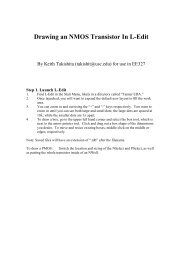Induction of Word and Phrase Alignments for Automatic Document ...
Induction of Word and Phrase Alignments for Automatic Document ...
Induction of Word and Phrase Alignments for Automatic Document ...
Create successful ePaper yourself
Turn your PDF publications into a flip-book with our unique Google optimized e-Paper software.
Computational Linguistics Volume 1, Number 1<br />
is much more important to get content words right, rather than functions words. When<br />
words on a stop list <strong>of</strong> 58 function words <strong>and</strong> punctuation were ignored, the kappa<br />
value rose to 0.68. Carletta (1995) has suggested that kappa values over 0.80 reflect very<br />
strong agreement <strong>and</strong> that kappa values between 0.60 <strong>and</strong> 0.80 reflect good agreement. 4<br />
2.3 Results <strong>of</strong> annotation<br />
After the completion <strong>of</strong> these alignments, we can investigate some <strong>of</strong> their properties.<br />
Such an investigation is interesting both from the perspective <strong>of</strong> designing a model, as<br />
well as from a linguistic perspective.<br />
In the alignments, we found that roughly 16% <strong>of</strong> the abstract words are left unaligned.<br />
This figure includes both st<strong>and</strong>ard lexical words, as well as punctuation. Of<br />
this 16%, 4% are punctuation marks (though not all punctuation is unaligned) <strong>and</strong> 7%<br />
are function words. The remaining 5% are words that would typically be considered<br />
content words. This rather surprising result tells us that any model we build needs to<br />
be able to account <strong>for</strong> a reasonable portion <strong>of</strong> the abstract to not have a direct correspondence<br />
to any portion <strong>of</strong> the document.<br />
To get a sense <strong>of</strong> the importance <strong>of</strong> producing alignments at the phrase level, we<br />
computed that roughly 75% <strong>of</strong> the alignments produced by humans involve only one<br />
word on both sides. In 80% <strong>of</strong> the alignments, the summary side is a single word (thus<br />
in 5% <strong>of</strong> the cases, a single summary word is aligned to more than one document word).<br />
In 6.1% <strong>of</strong> the alignments, the summary side involved a phrase <strong>of</strong> length two, <strong>and</strong> in<br />
2.2% <strong>of</strong> the cases it involved a phrase <strong>of</strong> length three. In all these numbers, care should<br />
be taken to note that the humans were instructed to produce phrase alignments only<br />
when word alignments were impossible. Thus, it is entirely likely that summary word<br />
i is aligned to document word j <strong>and</strong> summary word i + 1 is aligned to document word<br />
j + 1, in which case we count this as two singleton alignments, rather than an alignment<br />
<strong>of</strong> length two. These numbers suggest that looking at phrases in addition to words is<br />
empirically important.<br />
Lexical choice is another important aspect <strong>of</strong> the alignment process. Of all the<br />
aligned summary words <strong>and</strong> phrases, the corresponding document word or phrase was<br />
exactly the same as that on the summary side in 51% <strong>of</strong> the cases. When this constraint<br />
was weakened to looking only at stems (<strong>for</strong> multi-word phrases, a match meant that<br />
each corresponding word matched up to stem), this number rose to 67%. When broken<br />
down into cases <strong>of</strong> singletons <strong>and</strong> non-singletons, we saw that 86% <strong>of</strong> singletons are<br />
identical up to stem <strong>and</strong> 48% <strong>of</strong> phrases are identical up to stem. This suggests that<br />
looking at stems, rather than lexical items, is useful.<br />
Finally, we investigated the issue <strong>of</strong> adjacency in the alignments. Specifically, we<br />
consider the following question: given that a summary phrase ending at position i is<br />
aligned to a document phrase ending at position j, what is a likely position in the document<br />
<strong>for</strong> the summary phrase beginning at position i + 1. It turns out that this is<br />
overwhelmingly j + 1. In Figure 2, we have plotted the frequencies <strong>of</strong> such relative<br />
“jumps” over the human-aligned data. This graph suggests that a model biased toward<br />
stepping <strong>for</strong>ward monotonically in the document is likely to be appropriate. However,<br />
it should also be noted that backward jumps are also quite common, suggesting that a<br />
monotonic alignment model is inappropriate <strong>for</strong> this task.<br />
they serve the same role, but certainly do not mean the same thing.<br />
4 All annotator agreement figures are calculated only on the last 40 〈document, abstract〉 pairs, which<br />
were annotated independently.<br />
6


